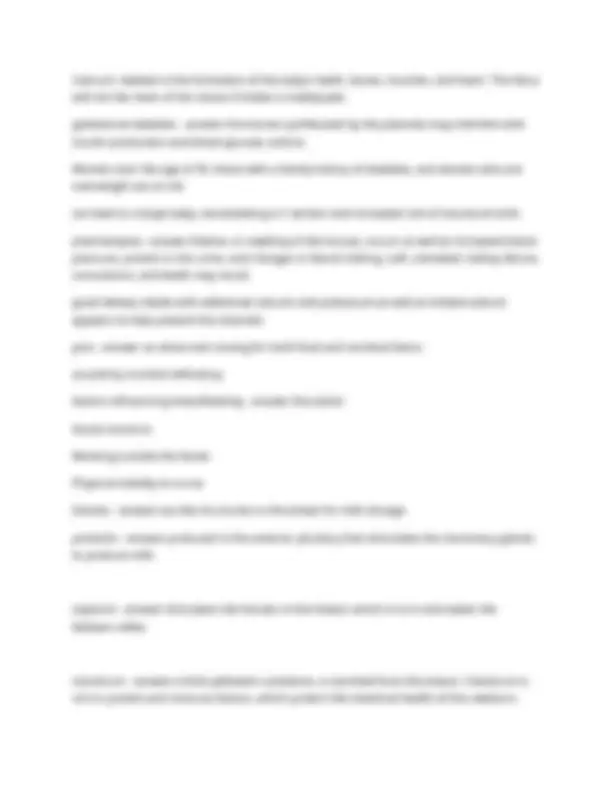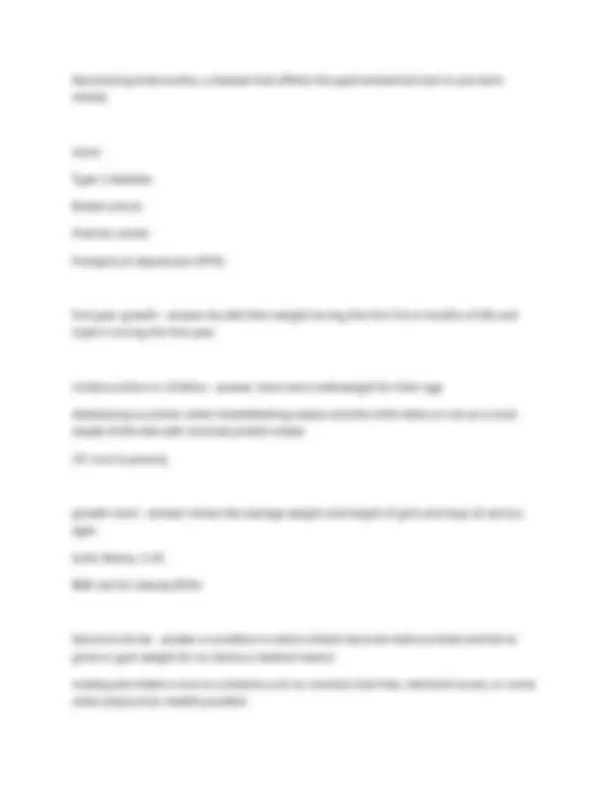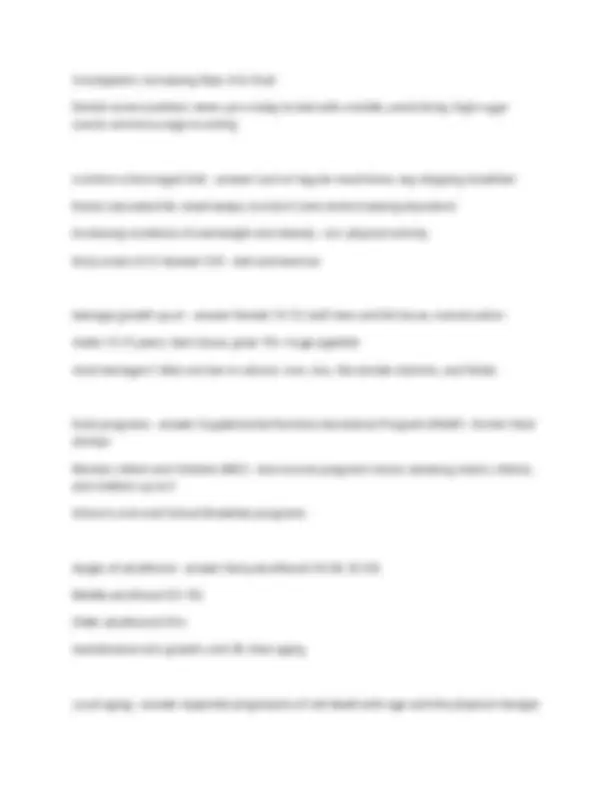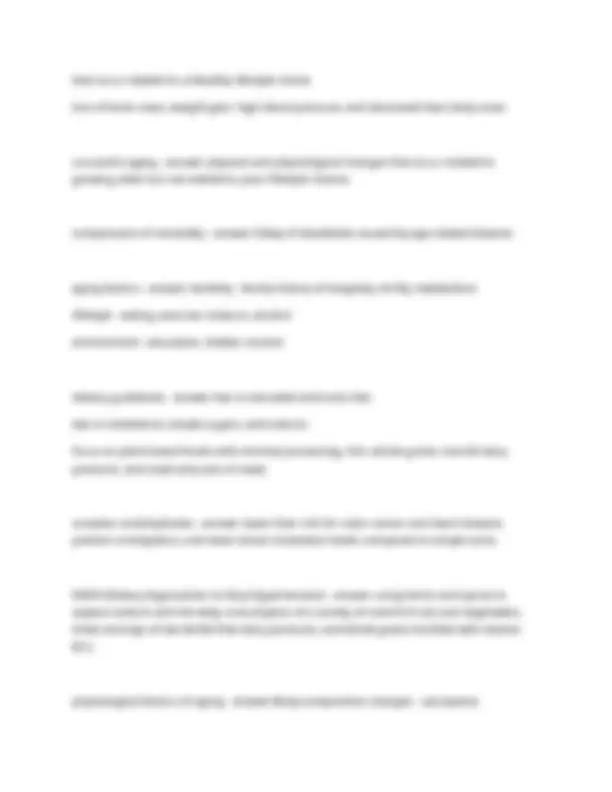








Study with the several resources on Docsity

Earn points by helping other students or get them with a premium plan


Prepare for your exams
Study with the several resources on Docsity

Earn points to download
Earn points by helping other students or get them with a premium plan
Community
Ask the community for help and clear up your study doubts
Discover the best universities in your country according to Docsity users
Free resources
Download our free guides on studying techniques, anxiety management strategies, and thesis advice from Docsity tutors
BIOD 121 Module 6 Exam Questions And Accurate Answers.
Typology: Exams
1 / 11

This page cannot be seen from the preview
Don't miss anything!







Healthy pregnancy - answer adequate intake of vitamins and minerals healthy body weight controlling existing health conditions avoidance of teratogens Teratogens - answer compounds that can increase the risk of a birth defect caffeine, drugs, alcohol, and tobacco. Tobacco: miscarriage, stillbirth, preterm delivery, and low birth weight infants alcohol: FAS, physical and mental disabilities and growth retardation drugs: low birth weight, preterm delivery, miscarriage, birth defects, and infant addiction. Blastogenic stage - answer (Day 1 to 14): A period of rapid cell division Day 14: An embryo is formed. Embryonic stage - answer (Week 2 to 8): The organ system develops. Week 5: The heart begins to beat. Week 8: The embryo is now known as a fetus. Fetal Stage - answer (Week 9 to 40): Period of continual growth and development zygote - answer formed from combination of egg and sperm placenta - answer provides oxygen and nutrients from the mother's blood to the fetus and also allows for the transfer of waste from the fetus and into the mother's system for excretion first trimester - answer exposure to toxins and inadequate nutrient intake can have an adverse effect on the fetus quality of the mother's diet is more important than the quantity second trimester - answer development of the hands, feet, arms, and legs occurs, and the
fetus begins to resemble a baby physiological changes to mom's body in order to support the pregnancy and prepare for birth. third trimester - answer fetus will double in length and will increase weight to approximately 7 to 9 pounds. low birth weight (LBW) - answer a birth weight of less than 5.5 pounds small for gestational age (SGA) - answer an infant small in size, measured relative to its gestational stage calorie during pregnancy - answer quality more important than quantity need for certain nutrients increase by 50% during pregnancy. calorie needs during the second and third trimester only increases by approximately 20%. adequate weight gain - answer 25-35 pounds total 1-4 pounds during the first trimester and then approximately 1 pound per week during the remainder of the pregnancy. Underweight: 28 to 40 pounds Normal: 25 to 35 pounds Overweight: 15 to 25 pounds Obese: 11 to 20 pounds increased protein/carbohydrate needs - answer Pregnant moms require an additional 25 grams protein per day above RDA inadequate carbs --> ketones, harmful to fetal brain vitamin needs - answer Folate is needed for cell development and the synthesis of DNA. Without adequate folate, the pregnant mom may develop anemia and fetus may have neural tube defects increased mineral needs - answer especially true of iodide, zinc, iron, and calcium. iron: required due to increased blood volume as well as to provide iron stores to the fetus. anemia --> preterm delivery, low birth weight infants, and increased risk for fetal death.
breast milk composition - answer Several days following delivery, the milk composition changes, and although it has a thin watery, bluish appearance, it is extremely high in nutritional quality can change according to infant's needs breastfeeding nutritional needs - answer similar to what a woman needs during the second and third semesters of her pregnancy vitamins A, E, C, and riboflavin as well as several minerals increase Calorie needs are higher during lactation than during pregnancy 13 cups of fluid per day will allow adequate milk production at least 1800 calories, moderate amounts of fat, and a variety of fruits, vegetables, whole grains, and dairy products breastfeeding lowers risk of - answer infant: Ear infections Stomach viruses Diarrhea Respiratory infections Atopic dermatitis Asthma Obesity Type 1 and Type 2 diabetes Childhood leukemia Sudden infant death syndrome or SIDS
Necrotizing enterocolitis, a disease that affects the gastrointestinal tract in pre-term infants mom: Type 2 diabetes Breast cancer Ovarian cancer Postpartum depression (PPD) first year growth - answer double their weight during the first 4 to 6 months of life and triple it during the first year. Undernutrition in children - answer short and underweight for their age developing countries: when breastfeeding ceases and the child relies on rice as a main staple of the diet with minimal protein intake US: due to poverty growth chart - answer shows the average weight and height of girls and boys at various ages birth-36mos, 2- BMI risk for obesity 85%+ failure to thrive - answer a condition in which infants become malnourished and fail to grow or gain weight for no obvious medical reason inadequate intake is due to a disease such as constant diarrhea, intestinal issues, or some other physical (or health) problem
veggies before fruits delay allergens: eggs, dairy, soy, peanuts, and fish Foods to avoid in first year - answer honey, choking hazards, excess juice, milk nutrition 2-5 years - answer nutrient-dense foods with limited sugar, fat, and sodium preschool children have more taste buds than adults and are more sensitive to taste one-bite rule, food jags offer same food a variety of ways preschool feeding issues: picky eater - answer 1 tablespoon of fruits, vegetables, and meat/beans per year of life offering a variety of healthy foods, allowing children to make their choices and avoiding nagging, force feeding, and bribery at meal times intake over week, not one meal preschool feeding issues: snacking - answer 6 small meals due to small stomachs only 4-6oz juice per day <6y, 8-12oz 7y+ preschool feeding issues: vegetables - answer "eat the rainbow" child help prepare include fruits child malnutrition - answer Iron deficiency anemia (6-24m): fortified cereal, meat
Constipation: increasing fiber, 4-5c fluid Dental caries (cavities): never put a baby to bed with a bottle, avoid sticky, high sugar snacks and encourage brushing nutrition school-aged kids - answer Lack of regular meal times, esp skipping breakfast Excess saturated fat: small swaps, but don't over-restrict (eating disorders) Increasing incidence of overweight and obesity - incr physical activity Early onset of CV disease T2D - diet and exercise teenage growth spurt - answer female 10-13, both lean and fat tissue, menstruation males 12-15 years, lean tissue, grow 1ft+, huge appetite most teenagers' diets are low in calcium, iron, zinc, fat-soluble vitamins, and folate food programs - answer Supplemental Nutrition Assistance Program (SNAP) - former food stamps Women, Infant and Children (WIC) - low-income pregnant moms, lactating moms, infants, and children up to 5 School Lunch and School Breakfast programs stages of adulthood - answer Early adulthood (19-34, 35-50) Middle adulthood (51-70) Older adulthood (70+) maintenance w/o growth until 30, then aging usual aging - answer expected progression of cell death with age and the physical changes
Skeletal system changes - bone loss Digestive system changes - lactose malabsorption and decreased stomach acid Chronic disease Medications psychosocial factors of aging - answer Social isolation Depression Alzheimer's + dementia Economic factors DETERMINE nutrition screening - answer Disease Eating poorly Tooth loss Economic hardship Reduced social contact Medications Involuntary weight loss Needs assistance Elderly, older than 80 years of age USDA recommendations for older people - answer Increased nutrient density Adequate fluid and fiber intake Lean meats to provide iron, protein, zinc, and vitamin B-6 and B-12, which are frequently inadequate
Use of a multivitamin and mineral supplement Modified physical activity to maintain lean body tissue and prevent unwanted weight gain from fatty tissue.